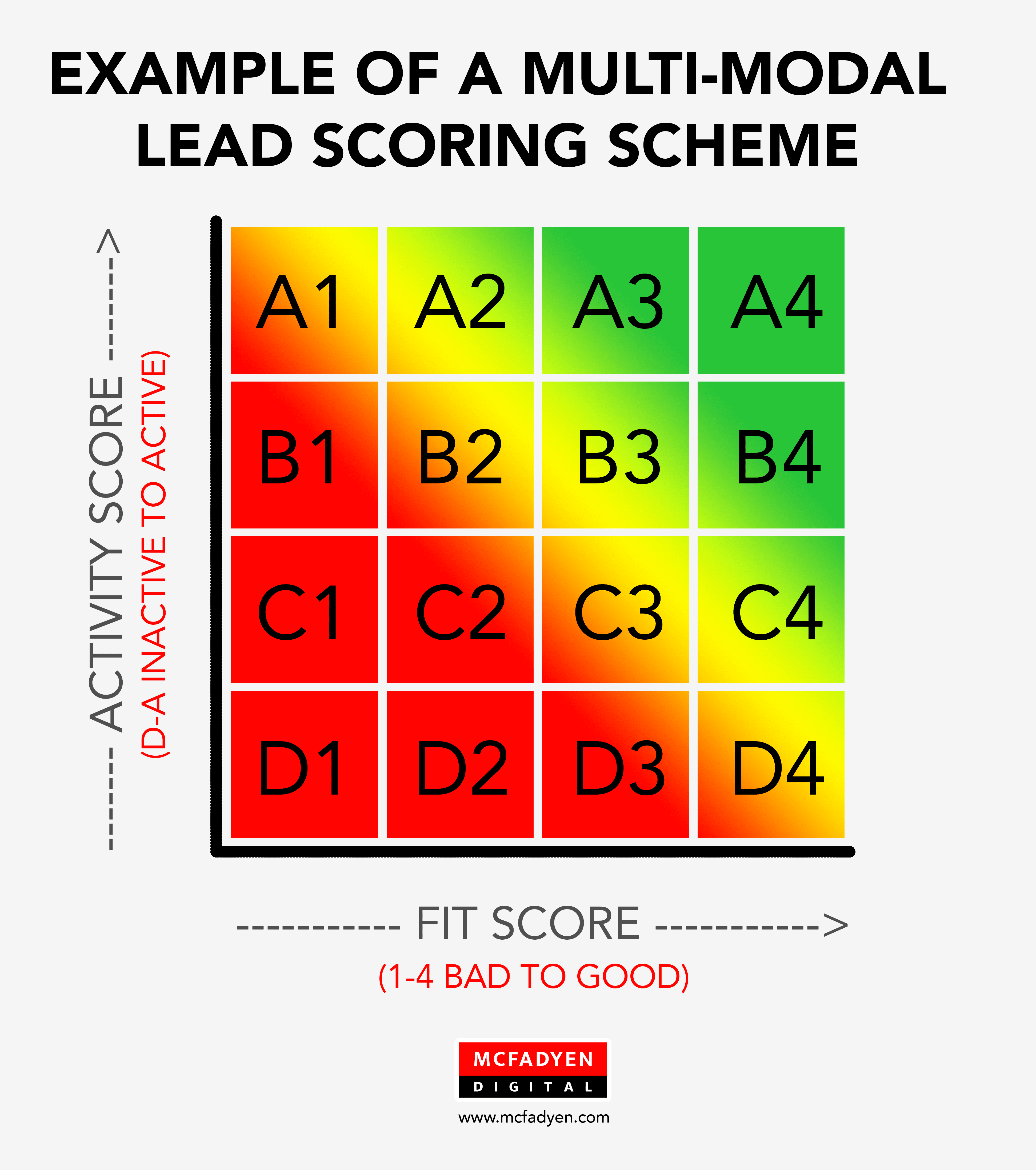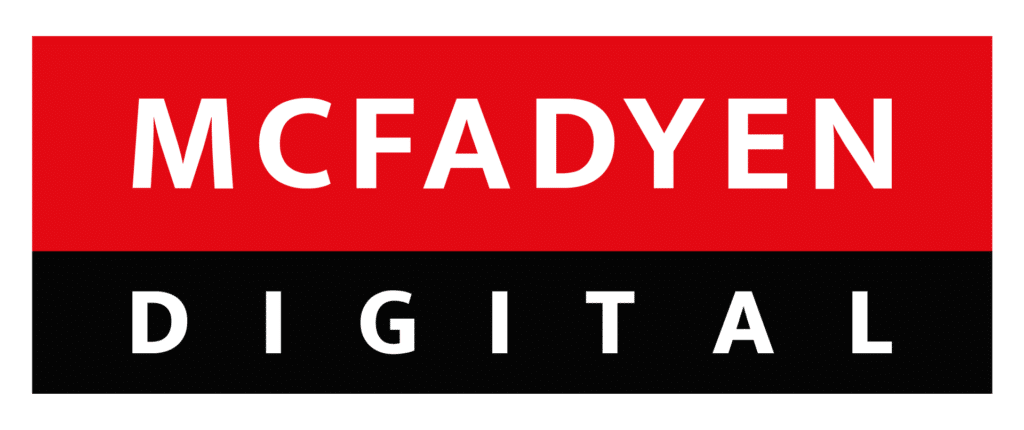
Lead scoring remains one of the most efficient ways to add a degree of automation to the top of a B2B sales funnel, but it’s usefulness can also be extended in other areas such as loyalty marketing. The big question then becomes; how do you do Lead Scoring the “right” way so that it is an asset to your sales associates, rather than a hinderance? The answer is multifaceted, but boils down to a few key components; giving your sales reps context in relation to the scoring, having situational awareness of a buyer’s stage in the cycle, and ensuring that the scoring method employed matches your organization’s business objectives.

In this example, an A4 is a perfect fit for this business’ services and has been very active, while a D1 is not a fit at all and has not been active. Sales rep outreach efforts and targeted marketing is more likely to connect with those in the green areas.
The Good, the Bad, and the Unqualified…
When done properly, lead scoring can help sales reps to focus only on organizations who are the right fit and only on individuals who have demonstrated a high degree of interest. Additional scoring schemes can also be applied to such areas customer loyalty marketing and strategic-account marketing. When scoring is working, it serves as an accelerant leading to your reps having more relevant conversations with the right people. The result should be higher first appointment rates, accelerated opportunity cycles, and more converted revenue.
When done the wrong way, lead scoring scoring becomes a meaningless nuisance to the sales team and is summarily dismissed as such. If you are reading this and rolled your eyes at any part where I was extolling the benefits of scoring, my condolences on having experienced a poor implementation of the practice. Bad scoring results in unqualified leads flooding sales, marketing getting frustrated by a lack of conversions, and the perception that the score is just a meaningless number.
Communication and Context Add Relevance to a Score
The success or failure of a lead scoring effort is almost always directly related to how much communication there has been between marketing and sales regarding how a score is calculated. Too often, marketing teams view it as their sole responsibility to get the ball rolling on a scoring model. The sales reps are talking to these customers every single day, so their insights into what these buyers truly value should be the first consideration when conceiving a scoring model. Kicking off the effort with a joint session that includes sales and marketing leadership, as well as frontline associates, greatly enhances the chances for success.
The result of completely aligned approach is context; context of buyer action and context of where a buyer is in their journey. A lead score is only a meaningless number when the sales rep doesn’t understand why that score was reached and what that particular score means. When the reps can look at a lead record in a CRM platform and see precisely what actions a lead took to reach a particular score, they can then personalize their conversation to match the demonstrated areas-of-interest of the potential buyer.
The other important contextual area to be aware of is where the potential buyer is in their overall journey. If a lead has been viewing content slowly over a period of time and then suddenly demonstrates a clear buying sign, you may be able to skip the initial conversations with a junior business development rep and escalate directly to a more senior resource capable of having a more in-depth conversation. The ability to skip stages of your own sales escalation path can add value to the buyer and accelerate your opportunity cycle.
Scoring Models Must Align with Business Objectives
Being mindful of the business objectives of your marketing team is the best way to start designing a successful scoring program. These objective can help you identify key elements such as who you should be targeting and prioritizing, and what specific content and actions should be scored the highest.
In its most basic form, Lead Scoring is essentially activity scoring. Points are being assigned for desired actions taken by the prospect. The more points, the better…in theory. In reality, activity scoring is only informing us that someone is doing “things”, but it doesn’t let us know if they are doing the “right things”, or if they are even someone we should be focusing attention on. Introducing a “Fit” score in addition to the “Activity” score can help filter out a lot of the noise that comes along with a demand generation program. While activity scoring is calculated based on desired prospect actions, the fit score assigns points based on how well both the business and the individual fit your ideal prospect profile…the people most likely to buy from you. Assigning points for a company being in the right industry, location, with a desireable revenue number, and a known need for your offering gets a high score. The decision maker you are targeting gets points for her title, for providing an email address and phone number, and for being identified as the key executive, and so on. This simple addition now provides you with an immediate filter for organizations, individual roles, and an indicator of how active those individuals have been.
Further lead scoring alignment against business objectives can see scoring dimensions added for each product category or area-of-interest in addition to the “Fit” and general “Activity” scores to add additional insights and opportunities for personalization. Compounding iterations such as the aforementioned categorical scoring can also extend into the loyalty marketing arena. “Lead scoring” platforms are rules engines and there is no reason these rules engines can’t be programmed for customer loyalty, upsell, and cross-sell purposes. If a new B2B customer recently placed their first order through your platform and a scoring scheme is in place to monitor post-sale activity, outreach can begin immediately when that customer becomes interested in a new product or service area. The possibilities are as limitless as the ways you can figure out how to meaningfully categorize desired actions.
Stay Tuned…
Now that we’ve discussed why lead scoring is still relevant for B2B organizations, the next article in this series will examine how these scoring programs can be used to automate the personalization of content for both prospects and existing customers. If you have any questions or comments, please connect with us on social media or shoot us a note at engage@mcfadyen.com.
AUTHOR
Thomas Gaydos
CMO & Digital Marketing Practice Lead
McFadyen Digital
@ThomasGaydos
Related Articles
Turn Insight Into Impact.
Start Today.




